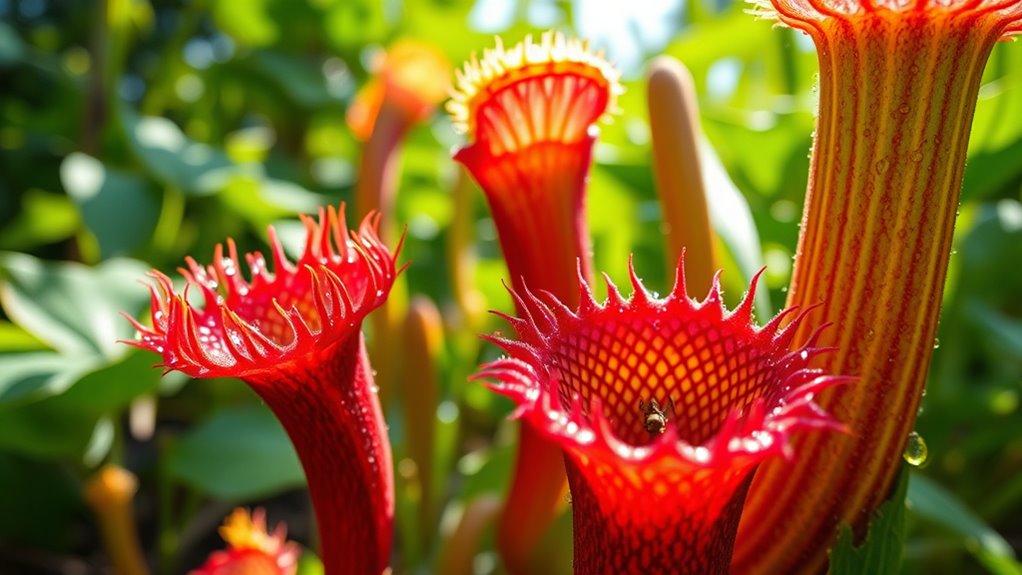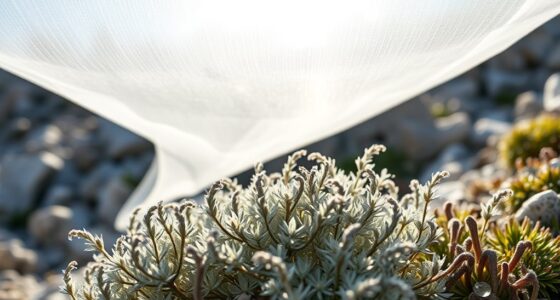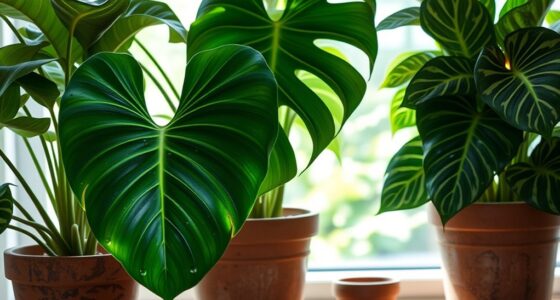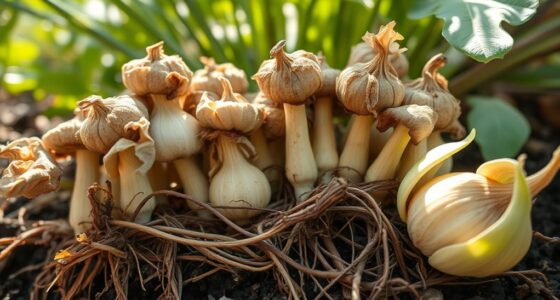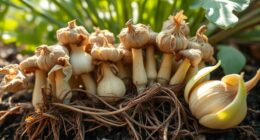During summer, rare carnivorous plants face unique care challenges like maintaining proper moisture levels and preventing pests. You should water consistently, using distilled water and ensuring good drainage, while monitoring soil moisture daily. Pests like aphids and spider mites can be a threat, so inspect your plants regularly and respond promptly. Although natural insect trapping helps, some supplemental feeding supports growth. To discover more tips on summer care, continue exploring how to keep your plants healthy all season long.
Key Takeaways
- Maintain consistently moist soil using distilled or rainwater to prevent mineral buildup and root rot.
- Regularly inspect plants for pests like aphids and spider mites, using natural or organic control methods.
- Adjust watering frequency due to increased evaporation; bottom watering helps avoid disturbing traps.
- Provide small live insects every few weeks if natural prey is insufficient, avoiding overfeeding.
- Ensure good airflow and cleanliness to prevent mold, fungal issues, and pest infestations during summer.
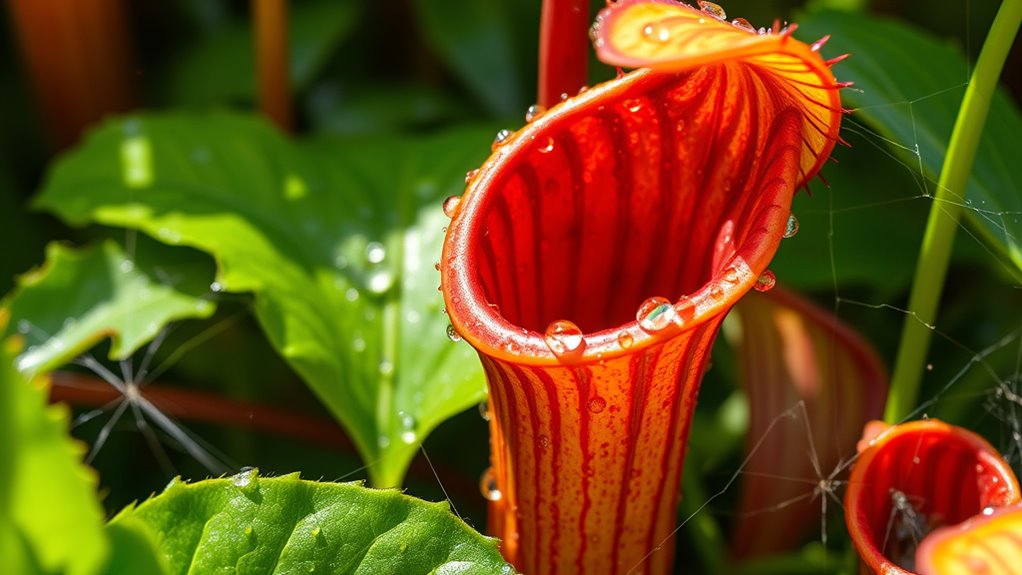
Have you ever wondered how some plants manage to survive in nutrient-poor soils? Carnivorous plants are a fascinating example, thriving where most others would struggle. For rare varieties, summer presents unique challenges, especially when it comes to feeding and care. These plants have adapted to obtain nutrients by trapping insects, but that doesn’t mean you can neglect their basic needs. Proper watering techniques and pest prevention are essential to keeping them healthy during the warmer months.
Carnivorous plants thrive in nutrient-poor soils but need proper care, watering, and pest control in summer.
When it comes to watering, you need to be precise. Many carnivorous plants prefer consistently moist soil, but overwatering can lead to root rot, while underwatering causes dehydration. During summer, evaporation rates increase, so you might need to water more frequently. Use distilled or rainwater, as tap water often contains minerals that can harm these sensitive plants. Guarantee their containers have good drainage to prevent water from pooling at the bottom. A common technique is to keep the soil damp but not soggy, checking daily and adjusting as needed. Bottom watering works well for many species, allowing the plant to absorb moisture through the drainage holes without disturbing the delicate traps or roots.
Pest prevention is another essential aspect of summer care. Warm weather often invites pests like aphids, spider mites, or fungus gnats, which can weaken or even kill rare carnivorous plants if left unchecked. Regularly inspect your plants, especially the traps and soil surface, for signs of pests. A gentle rinse with water can dislodge small insects, and introducing natural predators or organic insecticides can prevent infestations. Be cautious with chemical treatments, as many pesticides can harm the plants themselves. Keeping the environment clean and free of debris also reduces pest hiding spots. Proper airflow and humidity levels are important, too, because stagnant, overly humid conditions can promote mold or fungal issues, which are common summer pests.
Feeding your rare carnivorous plants during summer isn’t always necessary if they’re catching insects naturally, but supplemental feeding can boost growth. Just make sure not to overdo it; a small, live insect every few weeks is enough for most species. Maintaining a balanced approach—watering carefully, preventing pests proactively, and providing the right environment—will help guarantee your rare plants thrive through the summer months. Remember, these plants are delicate, but with attentive care, they can flourish and continue to amaze you with their unique adaptations.
Frequently Asked Questions
How Often Should I Feed My Carnivorous Plants During Summer?
You should consider your plant’s feeding frequency during summer carefully. Typically, carnivorous plants don’t need frequent feeding; once every two weeks is usually enough. Seasonal adjustments are essential—reduce feeding in cooler months and increase it slightly in summer if natural prey is scarce. Keep an eye on your plant’s health, and avoid overfeeding, which can cause harm. Proper care guarantees your plant thrives through seasonal changes.
What Are Signs of Overfeeding in Carnivorous Plants?
Many believe overfeeding boosts plant growth, but it can harm your carnivorous plants. Signs of overfeeding include stalled growth, mold, or decay around the traps, and a decline in plant health. If you notice trapped prey rotting or traps turning brown, reduce feeding frequency immediately. Your plants need just enough nourishment—too much can weaken them. Observe closely to maintain a healthy balance and guarantee their long-term vitality.
Can I Use Live Insects or Only Dried Ones?
You can use live insects for feeding, but dried insects are also suitable. Both insect types work well, provided you match the feeding frequency to your plant’s needs. Live insects might stimulate natural hunting behavior, while dried ones are easy to store and handle. Just guarantee you’re not overfeeding and choose appropriate insect sizes. Regularly observe your plant for signs of overfeeding or stress, adjusting feeding accordingly.
How Do I Prevent Mold and Rot After Feeding?
To prevent mold and rot after feeding your carnivorous plant, make certain you remove any leftover insects or debris promptly. Use mold prevention techniques like increasing air circulation and avoiding excess moisture. Rotate feeding spots to prevent rot control issues, and consider applying a light fungicide if mold persists. Keeping the plant dry around the feeding area and maintaining proper humidity levels also helps safeguard against mold and rot.
Are There Specific Watering Routines in Summer for These Plants?
You should adjust your watering schedule to match summer humidity, balancing moisture without overwatering. While high summer humidity helps keep your rare carnivorous plants healthy, avoid letting the soil stay soggy. Water early in the day to prevent mold and rot, ensuring the soil remains moist but not waterlogged. This rhythm supports healthy growth, keeping your plants thriving amid the summer heat and humidity fluctuations.
Conclusion
While caring for rare carnivorous plants during summer can seem formidable, your dedication pays off in their vibrant growth. If concerns about feeding or temperature sensitivity arise, remember that providing the right environment and occasional supplemental feeding guarantees their health. With patience and attention, you’ll enjoy the unique beauty of these extraordinary plants year-round. Embrace the challenge, and you’ll find yourself rewarded with a fascinating, thriving addition to your collection that truly stands out.

